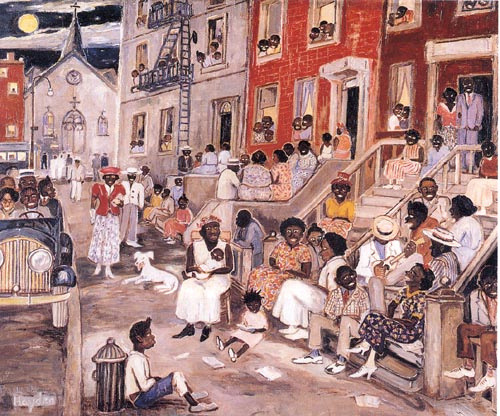Harlem Renaissance
Monday, March 19, 2012
Art Analysis: Lois Mailou Jones
This painting is "The Ascent of Ethiopia" by Lois Mailou Jones. It shows the Evolution of African-American culture. The bottom of the painting with the figure in a headdress represents living in Africa, and going up you can see the struggle to finally make it to the Harlem Renaissance. I noticed three HR themes in this painting: Identification with race, pride, and exploration of Negro heritage and history.
This painting immediately stood out to me because of the interesting composition and good use of complimentary colors. I think the the symbols like the pyramids and the city building were a creative way for the artist to express her idea.
Art Analysis: Palmer Hayden
The painting above is called "Midsummer Night in Harlem" was was painted by Palmer Hayden. The piece depicts life of the African-American community in Harlem. The artist used mostly light colors, even though it is the middle of the night. This gives the scene in the painting a vibrant atmosphere that looks like it is full of life. The people all seem to be laughing and having a good time, representing the pride and community in Harlem.
I chose this painting because while searching it stuck out to me. I like the composition and there is a lot going on in the picture which I think is interesting.
Source:
http://www.pbs.org/wnet/aaworld/arts/hayden.html
Biography: Duke Ellington
Duke Ellington was a musician active during the Harlem Renaissance. He was born as Edward Kennedy Ellington on April 29, 1899 in Washington, D.C. His parents brought him up as a gentleman, which earned him the nickname "Duke". Both of his parents were pianists, so it was only natural that he picked up the instrument himself at the early age of seven. In the 1920s, Ellington moved to Harlem and started to play shows at The Cotton Club.
Though he mainly focused on jazz, Ellington's music spanned many genres, including blues, gospel, and classical. During his 50-year career Ellington composed over a thousand pieces and was a widespread influence on jazz music.
Duke Ellington represents the Harlem Renaissance theme of pride. He believed that representing African-American culture in a positive way was the best way to fight racism.
Source:
http://en.wikipedia.org/wiki/Duke_ellington
Sunday, March 18, 2012
Biography: Alain Locke
"Art must discover and reveal the beauty which prejudice and caricature have overlaid."
Locke was the author and editor of many books, his most well-known being The New Negro. The book is a collection of literature by himself as well as many other black writers and artists. It popularized the term "New Negro" which was used during the Harlem Renaissance to refer to blacks who resisted being just what white society wanted them to be. The idea of the New Negro was an inspiration in many future black writer's work. Another of Locke's theories was on "cultural pluralism", which said that all cultures should be able to coexist without assimilating into each other. He later revised this idea and called it "cultural relativism".
Through his work, Alain Locke displays the Harlem Renaissance themes of pride and identifiation with race. He suggested black artists identify with their African roots, and his cultural pluralism theory states that one should be proud of their heritage while living together with people of other backgrounds. His work on "The New Negro" also reflects the theme of wanting to reconstruct the meaning of Negro.
Sources:
http://www.notablebiographies.com/Ki-Lo/Locke-Alain.html#b
http://en.wikipedia.org/wiki/Alain_Locke
Subscribe to:
Posts (Atom)



